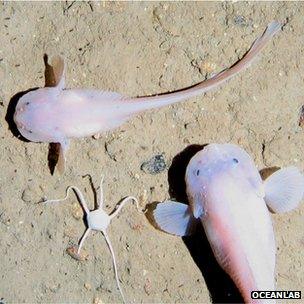Fishy molecule 'sets depth limit'
- Published

At more than 7,000m down, these snailfish are among the deepest fish known to science
Scientists say it is unlikely that any fish can survive in the oceans deeper than about 8,200 metres.
No fish has ever been seen living beyond this limit, but the researchers point to good physiological reasons why it should not be possible, also.
It rests on the particular molecular mechanism they use in their tissues to withstand crushing pressures.
To go deeper would require fish to evolve some other mechanism, the team tells the journal PNAS, external.
The all-important molecule is a so-called osmolyte called trimethylamine N-oxide (TMAO). It is what gives fish their “fishy smell”.
TMAO acts to stabilize the proteins fish use to build and maintain their cells.
Without its presence, the proteins would be distorted by the high pressures found at depth and stop functioning.
Cell barrier
The team had observed that fish species appeared to have increasing amounts of TMAO the deeper they went, and sought to test this relationship on hadal snailfish recovered from the bottom of the Kermedec Trench north of New Zealand.
This pinkish animal operates more than 7,000m down, preying upon small crustaceans that eat organic matter that rains from above.
One other type of fish has purportedly been trawled from deeper, but nothing has actually been observed swimming so far down.
"This is by far the deepest fish we've caught and analysed, and they have the highest levels of this TMAO molecule," lead author Prof Paul Yancey from Whitman College, Washington State, US, told BBC News.
What is more, the concentration is almost exactly on the line if one extrapolates from shallower species.
But extending that line forwards moves TMAO concentrations to a point where they would inhibit cell function, at about 8,000-8,500m’s depth.
Life's limits
“We know that if TMAO is too high, it makes proteins so stable they can’t work,” explained Prof Yancey.
“The myosin protein in muscle, for example, needs to flex for muscles to move, and too much TMAO would stop this happening.”

Amphipods use a number of osmolytes to survive the crushing pressures of the deep
The other possibility is that at these very high levels, the tissues would try osmotically to draw water into the fish, something that fully marine fish are not able to handle.
Although the vast majority of the ocean floor is shallower than 8,000m, it still leaves a handful of trenches that would seem to be out of reach for fish.
This would include the Pacific’s Mariana Trench, famously the deepest place in Earth’s oceans at nearly 11,000m.
While fish may not occupy these ultra-deep trenches, plenty of other lifeforms do.
Single-celled organisms, such as archaea, bacteria, and foraminifera, and even animals, like sea anemones and cucumbers, can be found in relatively large numbers.
Evolutionary space
“One of the types of organisms that I regularly bring up from the very deepest places is amphipods,” said co-author Dr Alan Jamieson from Aberdeen University, UK.
“These crustaceans are incredibly pressure-tolerant. They can handle amazing compressions and decompressions. But they appear to be using five of these osmolytes, whereas fish use just the one, TMAO.”
To go deeper then, fish would have to evolve additional mechanisms of their own. And that raises an interesting question: why have they not done so?
The authors speculate that perhaps the very deepest points in the ocean have opened up faster than fish have been able to develop the adaptations necessary to invade that space.
"How deep did the trenches used to be? If they were once only 8,000m deep - that answers this interesting question. We now have to overlay evolutionary biology with geological history," Dr Jamieson told BBC News
Prof Yancey's study was funded by the US National Science Foundation.
Dr Alan Jamieson describes the fish that live 7,700m below sea level
Jonathan.Amos-INTERNET@bbc.co.uk and follow me on Twitter: @BBCAmos, external
- Published3 March 2014
- Published18 March 2013
- Published27 March 2012
- Published26 March 2012
- Published2 February 2012